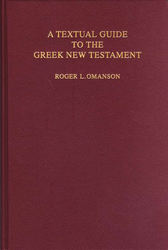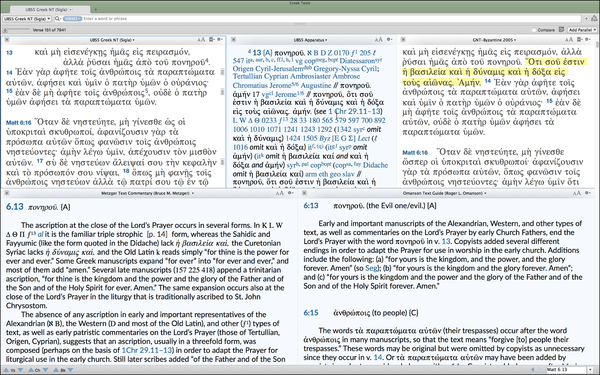 I’ve written before about taking a class in textual criticism under John Polhill, back in the 90s. I knew nothing about the subject beforehand, but the class stands out as one of the favorite of my MDiv studies. One of our textbooks was A Textual Commentary of the Greek New Testament by the late Bruce M. Metzger. This work, a running commentary of the textual variants chosen by the editorial committee of the United Bible Societies’ Greek New Testament, still remains a standard work to this day.
I’ve written before about taking a class in textual criticism under John Polhill, back in the 90s. I knew nothing about the subject beforehand, but the class stands out as one of the favorite of my MDiv studies. One of our textbooks was A Textual Commentary of the Greek New Testament by the late Bruce M. Metzger. This work, a running commentary of the textual variants chosen by the editorial committee of the United Bible Societies’ Greek New Testament, still remains a standard work to this day.
Twelve years later after the second edition of Metzger’s Textual Commentary, Roger L. Omanson, on behalf of the United Bible Societies, published A Textual Guide to the Greek New Testament: An Adaptation of Bruce M. Metzger’s Textual Commentary for the Needs of Translators. Omanson’s work was made available for the Accordance Bible Software Library earlier this week.
Why was Omanson’s work necessary, and who would benefit from having it in addition to Metzger’s commentary? Many may not realize that Bible translators—especially those engaged in new translations in non-English languages—often do not have formal training in textual criticism. The textual apparatus at the bottom of a print Greek New Testament can sometimes be an intimidating reference for the uninitiated. In fact, although the editors of the United Bible Societies (UBS) and Nestle-Aland (NA) Greek New Testaments long ago standardized the content of the New Testament text itself, the apparatus of the UBS Greek NT was specifically developed as a less-complex resource than its NA counterpart for the needs of translators and beginning NT Greek students.
Interestingly enough, Metzger’s original commentary was “designed to assist translators and students who may not have available an extensive library” (preface to the first edition), but for some, Metzger’s commentary has remained too challenging. Omanson’s Textual Guide attempts to bridge Metzger’s work to any translator or interested party who does not have the time or resources to study textual criticism in depth.
In the preface, Omanson writes, “The notes are not intended to replace Metzger’s original notes, but merely to simplify and expand them.” Perhaps Omanson was being charitable here because I’m certain that many would simply use his Guide to the neglect of Metzger’s earlier work. Ideally, though, Metzger’s Textual Commentary and Omanson’s Textual Guide should be used side by side.
One can easily see in the above example the difference between Metzger (bottom left) and Omanson (bottom right). Note that Omanson always includes a gloss for the Greek phrase in question, the notes are more concise and easier to follow, and Omanson does not refer to the manuscript designations as often as Metzger since they are in the apparatus anyway.
Anyone who reads Omanson’s Textual Guide will still need to have a basic understanding of textual criticism–including basic terminology; an understanding of the UBS ranking system of variants along the A, B, C, D scale; and at least a moderate understanding of NT Greek. Fortunately, there’s a crash course in textual criticism, including terminology, in the introductory materials of the book. And since Omanson is aiming for translators, he also occasionally interacts with major translations of the Bible to offer examples of how a text can be translated or to point to which variant a particular translation may have followed.
Roger Omanson’s Textual Guide to the Greek New Testament is available by itself, but the best value can be found by obtaining it as part of the new Stuttgart Scholarly Add-on from the German Bible Society.
Translators and students will find Omanson’s Guide helpful, but so will anyone interested in textual criticism. If textual criticism is new to you, the explanations at the beginning of Omanson’s book will be extremely helpful. And for the uninitiated, I might also point to Philip Comfort’s New Testament Text & Translation Commentary which interacts more with translations of the Bible than even Omanson does. And if you have never studied biblical languages, I would point to the notes in the New English Translation (NET) of the Bible, which is a great “first stop” for textual issues on a fairly non-technical level.


